 Things are heating up in the entry-level/enthusiast end of the photography market, with Pentax announcing two new new dSLR cameras offering 6.1 effective megapixels.
Things are heating up in the entry-level/enthusiast end of the photography market, with Pentax announcing two new new dSLR cameras offering 6.1 effective megapixels.
The Pentax K100 and K110D cameras both offer high precision 11-point wide frame AF, ISO sensitivity from 200 to 3200 ISO, a large 2.5-inch LCD screen and a shutter speed extending from 30 secs to a superfast 1/4000 sec
The cameras are compatible with most of the huge selection of existing Pentax lenses, including PENTAX K-, KA-, KAF- and KAF2-mount lenses; screw-mount lenses (with an adapter); and 645- are 67-system lenses (with an adapter) – although there may be limited functionality with some older lenses.
K100D : non shake, non rattle and non roll
Entering a market already dominated by excellent low-price models by Nikon and Canon, Pentax are hoping that the anti-shake widget in the K100D – which effectively offers a two-stop advantage – will get punters waving their wads in their direction
 It’s Pentax’s first DSLR to feature a CCD-shift Shake Reduction system – and works by oscillating the CCD image sensor vertically and horizontally at high speed using magnetic force, while adjusting the speed of oscillation in proportion to the amount of camera shake detected by a built-in sensor (err, got that?).
It’s Pentax’s first DSLR to feature a CCD-shift Shake Reduction system – and works by oscillating the CCD image sensor vertically and horizontally at high speed using magnetic force, while adjusting the speed of oscillation in proportion to the amount of camera shake detected by a built-in sensor (err, got that?).
K110D – cheap’n’cheerful
The entry-level digital K110D is exactly the same as the K100D but comes without the Shake Reduction.
Both cameras come with Pentax’s smarty-pants Auto Picture Mode for point’n’shooters. This automatically selects one of the five Picture modes – including Portrait, Landscape and Macro – by calculating various photographic factors to assure top notch results.
There’s also the usual selection of scene modes including Night Scene, Surf & Snow, Text, Sunset, Kids and Museum
 The Pentax K100D (with smc 18-55mm lens) will be shunting off the shelves for around $700, while the K110D will ship with the same lens for a competitive $600.
The Pentax K100D (with smc 18-55mm lens) will be shunting off the shelves for around $700, while the K110D will ship with the same lens for a competitive $600.
Pentax K100D/ K110D specifications
Sensor 6.1 million effective pixels
Image sizes 3008 x 2000, 3008 x 2008 (RAW), 2400 x 1600, 1536 x 1024,
File formats JPEG (8-bit), RAW (12-bit), DCF, DPOF, PRINT Image Matching lll
Lens Mount Pentax KAF bayonet mount
Focus TTL Phase-matching 11-point wide autofocus system (SAFOX Vlll), AF Single, Manual, AF Continuous
Image Stabilization Shake Reduction (SR) system (K100 only)
AF assist lamp Yes (by built-in flash)
Metering TTL open-aperture 16-segment (coupled with lens and AF information), Multi-segment, Center-weighted, Spot
ISO sensitivity Auto, ISO 200, ISO 400, ISO 800, ISO 1600, ISO 3200
Exposure compensation +/- 2EV, 1/2EV or 1/3 EV steps
Exposure bracketing 3 frames within range of +/-0.5EV, +/-1.0EV, +/-1.5EV (0.5EV steps) or +/-0.3EV, +/-0.7EV, +/-1.0EV (0.3EV steps)
Shutter Electronically controlled vertical-run focal plane shutter
Shuttter speed 1/4000 – 30 sec
Modes Auto Picture mode, Picture mode, Scene, Program AE, Shutter Priority AE, Aperture Priority AE, Metered Manual, Bulb
Picture modes Portrait, Landscape, Macro, Action, Night Scene Portrait, Standard Flash Off
White balance Auto, Daylight, Shade, Cloudy, Tungsten Light, Fluorescent Light (W, D, N), Flash, Manual
Continuous shooting Approx 2.8 fps: JPEG(up to 5fps), RAW(up to 3fps)
Flash Built-in retractable P-TTL pop-up, Guide number 15.6
Viewfinder Fixed molded penta-mirror type, 96% field of view
LCD monitor 2.5-inch low temperature polysilicon TFT, 210,000 pixels
Connectivity USB 2.0 Hi-speed
Storage SD card
Power 4 x AA batteries(Alkaline, Lithium, rechargeable Ni-MH), 2 x CR-V3 llithium batteries, Optional AC adapter
Weight (no batt) 560 g (19.8 oz) 485 g
Dimensions 129.5 x 92.5 x 70 mm (5.1 x 3.6 x 2.8 in)
Pentax
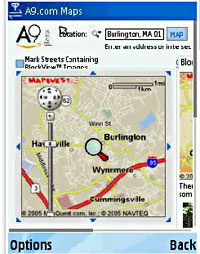 At the W3C conference in Edinburgh today, in a move to get the mobile industry (and possibly more) to standardise on a single Web browser, Nokia has released the source code for the mobile Web browser it developed last year.
At the W3C conference in Edinburgh today, in a move to get the mobile industry (and possibly more) to standardise on a single Web browser, Nokia has released the source code for the mobile Web browser it developed last year.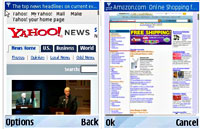 “We want to reduce the fragmentation currently in place in mobile browsing,” said Lee Epting, VP of Forum Nokia, Nokia’s software development support program.
“We want to reduce the fragmentation currently in place in mobile browsing,” said Lee Epting, VP of Forum Nokia, Nokia’s software development support program.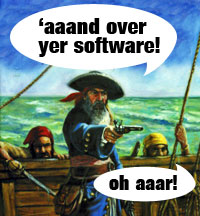 Over a third of all packaged software installed on PCs worldwide in 2005 was pirated, according to a study released by the Business Software Alliance (BSA), a trade group charged with fighting the use of unauthorised software.
Over a third of all packaged software installed on PCs worldwide in 2005 was pirated, according to a study released by the Business Software Alliance (BSA), a trade group charged with fighting the use of unauthorised software.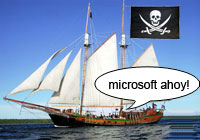 In fact, some have claimed that BSA’s accounting methods are so inaccurate that it amounts to scaremongering, especially when extrapolating figures from third world countries where just a few programs at full price would cost more than a citizen’s average annual income.
In fact, some have claimed that BSA’s accounting methods are so inaccurate that it amounts to scaremongering, especially when extrapolating figures from third world countries where just a few programs at full price would cost more than a citizen’s average annual income. In third place was France which notched up losses of $3.2 billion, accompanied by a piracy rate of 47 percent, while in Brit-land, 27 per cent of PC software used in the UK was claimed to be illegal.
In third place was France which notched up losses of $3.2 billion, accompanied by a piracy rate of 47 percent, while in Brit-land, 27 per cent of PC software used in the UK was claimed to be illegal.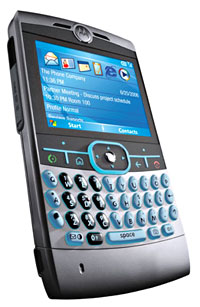 Months later than expected, Motorola’s new ‘Blackberry-killer’ smartphone, the Moto Q has finally been launched on the Verizon network in the US.
Months later than expected, Motorola’s new ‘Blackberry-killer’ smartphone, the Moto Q has finally been launched on the Verizon network in the US.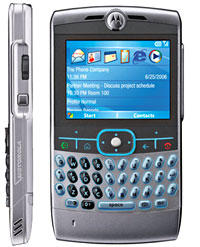 Shockley insisted that the Q is for people with a “life balance” (a what?) who want to use their phones to listen to music, take photos, record short videos and play games.
Shockley insisted that the Q is for people with a “life balance” (a what?) who want to use their phones to listen to music, take photos, record short videos and play games.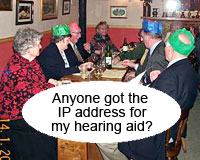 Crumblies all across the UK are being given the chance to try out the new fangled interwebby thing thanks to Age Concern’s ‘Silver Surfer Week.’
Crumblies all across the UK are being given the chance to try out the new fangled interwebby thing thanks to Age Concern’s ‘Silver Surfer Week.’ Silver Surfer Clubs
Silver Surfer Clubs Frankie’s story
Frankie’s story “Before I began the courses, I’d never even switched a computer on,” says Frank. “I’m now planning to create my own Website that my family and friends can visit to see my latest photographs and exchange messages. It’s a great way to share experiences and keep in touch.”
“Before I began the courses, I’d never even switched a computer on,” says Frank. “I’m now planning to create my own Website that my family and friends can visit to see my latest photographs and exchange messages. It’s a great way to share experiences and keep in touch.”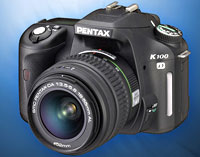 Things are heating up in the entry-level/enthusiast end of the photography market, with Pentax announcing two new new dSLR cameras offering 6.1 effective megapixels.
Things are heating up in the entry-level/enthusiast end of the photography market, with Pentax announcing two new new dSLR cameras offering 6.1 effective megapixels.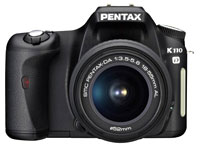 It’s Pentax’s first DSLR to feature a CCD-shift Shake Reduction system – and works by oscillating the CCD image sensor vertically and horizontally at high speed using magnetic force, while adjusting the speed of oscillation in proportion to the amount of camera shake detected by a built-in sensor (err, got that?).
It’s Pentax’s first DSLR to feature a CCD-shift Shake Reduction system – and works by oscillating the CCD image sensor vertically and horizontally at high speed using magnetic force, while adjusting the speed of oscillation in proportion to the amount of camera shake detected by a built-in sensor (err, got that?).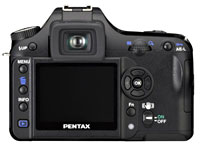 The Pentax K100D (with smc 18-55mm lens) will be shunting off the shelves for around $700, while the K110D will ship with the same lens for a competitive $600.
The Pentax K100D (with smc 18-55mm lens) will be shunting off the shelves for around $700, while the K110D will ship with the same lens for a competitive $600.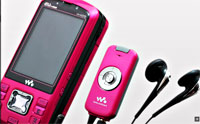 Sony Ericsson has announced its first Walkman phone for Japan today and it looks like a beaut.
Sony Ericsson has announced its first Walkman phone for Japan today and it looks like a beaut.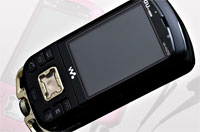 True to its Walkman heritage, the slide-out phone has a smorgasbord of built-in dedicated music controls, including a natty new mechanical navigation wotsit bolted on to the bottom of the phone.
True to its Walkman heritage, the slide-out phone has a smorgasbord of built-in dedicated music controls, including a natty new mechanical navigation wotsit bolted on to the bottom of the phone.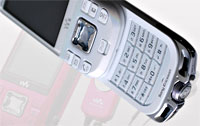 There’s been no firm announcement of the retail price yet, although it’s hotly rumoured to be around the $180 mark, and no announcement of a UK release yet, natch.
There’s been no firm announcement of the retail price yet, although it’s hotly rumoured to be around the $180 mark, and no announcement of a UK release yet, natch. Skype users are advised to upgrade their software in double quick time after a security bug was reported late last week by a security researcher in New Zealand.
Skype users are advised to upgrade their software in double quick time after a security bug was reported late last week by a security researcher in New Zealand. The bug affects all releases of Skype for Windows up to and including version 2.0.x.104, as well as version 2.5.x.0 up to and including 2.5.x.78. Skype advised users to upgrade to Skype 2.5, release 2.5.x.79 or later, or Skype 2.0, release 2.0.x.105 or later.
The bug affects all releases of Skype for Windows up to and including version 2.0.x.104, as well as version 2.5.x.0 up to and including 2.5.x.78. Skype advised users to upgrade to Skype 2.5, release 2.5.x.79 or later, or Skype 2.0, release 2.0.x.105 or later.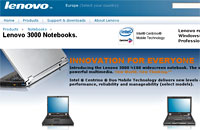 In a novel venture to bring personal computing to everyone, Microsoft has hooked up with laptop manufacturer Lenovo and chip makers AMD and Intel to launch a ‘pay-as-you-go’ service for buying PCs.
In a novel venture to bring personal computing to everyone, Microsoft has hooked up with laptop manufacturer Lenovo and chip makers AMD and Intel to launch a ‘pay-as-you-go’ service for buying PCs. “Today there are already more than 1 billion prepaid mobile phones used around the world, so we know FlexGo enables a familiar and comfortable pay-as-you-go model that works for people with variable or unpredictable income”, said Will Poole, Microsoft’s senior VP of the Market Expansion Group.
“Today there are already more than 1 billion prepaid mobile phones used around the world, so we know FlexGo enables a familiar and comfortable pay-as-you-go model that works for people with variable or unpredictable income”, said Will Poole, Microsoft’s senior VP of the Market Expansion Group. Sitting right next to the baked beans and cornflakes at a Tescos near you soon should be Tesco’s new range of cheapo MP3 players.
Sitting right next to the baked beans and cornflakes at a Tescos near you soon should be Tesco’s new range of cheapo MP3 players.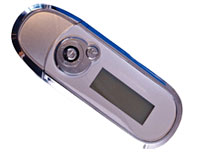 The interface is bog standard but straightforward – there’s not much to get confused about here – and the player connects to desktops via a USB interface.
The interface is bog standard but straightforward – there’s not much to get confused about here – and the player connects to desktops via a USB interface.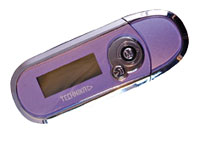 Tesco are no stranger to this MP3 thing, launching an
Tesco are no stranger to this MP3 thing, launching an